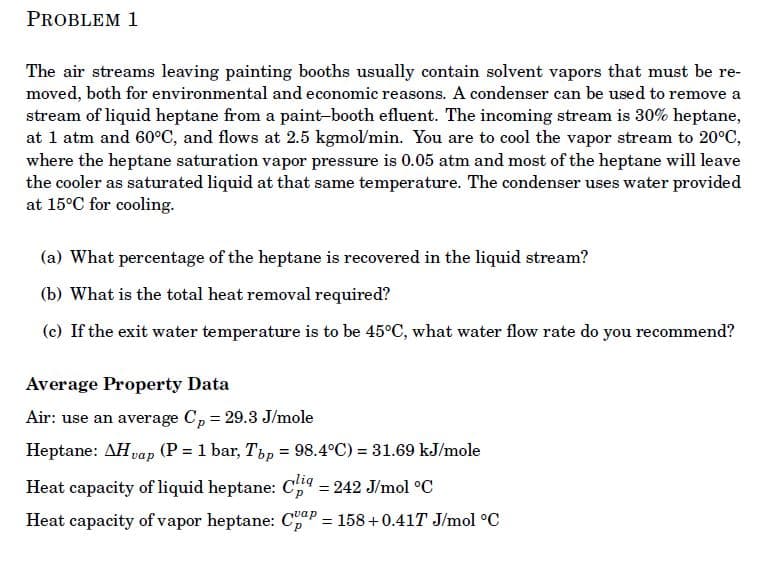The air streams leaving painting booths usually contain solvent vapors that must be re- moved, both for environmental and economic reasons. A condenser can be used to remove a stream of liquid heptane from a paint-booth efluent. The incoming stream is 30% heptane, at 1 atm and 60°C, and flows at 2.5 kgmol/min. You are to cool the vapor stream to 20°C, where the heptane saturation vapor pressure is 0.05 atm and most of the heptane will leave the cooler as saturated liquid at that same temperature. The condenser uses water provided at 15°C for cooling. (a) What percentage of the heptane is recovered in the liquid stream? (b) What is the total heat removal required? (c) If the exit water temperature is to be 45°C, what water flow rate do you recommend?
The air streams leaving painting booths usually contain solvent vapors that must be re- moved, both for environmental and economic reasons. A condenser can be used to remove a stream of liquid heptane from a paint-booth efluent. The incoming stream is 30% heptane, at 1 atm and 60°C, and flows at 2.5 kgmol/min. You are to cool the vapor stream to 20°C, where the heptane saturation vapor pressure is 0.05 atm and most of the heptane will leave the cooler as saturated liquid at that same temperature. The condenser uses water provided at 15°C for cooling. (a) What percentage of the heptane is recovered in the liquid stream? (b) What is the total heat removal required? (c) If the exit water temperature is to be 45°C, what water flow rate do you recommend?
Introduction to Chemical Engineering Thermodynamics
8th Edition
ISBN:9781259696527
Author:J.M. Smith Termodinamica en ingenieria quimica, Hendrick C Van Ness, Michael Abbott, Mark Swihart
Publisher:J.M. Smith Termodinamica en ingenieria quimica, Hendrick C Van Ness, Michael Abbott, Mark Swihart
Chapter1: Introduction
Section: Chapter Questions
Problem 1.1P
Related questions
Question
100%

Transcribed Image Text:PROBLEM 1
The air streams leaving painting booths usually contain solvent vapors that must be re-
moved, both for environmental and economic reasons. A condenser can be used to remove a
stream of liquid heptane from a paint-booth efluent. The incoming stream is 30% heptane,
at 1 atm and 60°C, and flows at 2.5 kgmol/min. You are to cool the vapor stream to 20°C,
where the heptane saturation vapor pressure is 0.05 atm and most of the heptane will leave
the cooler as saturated liquid at that same temperature. The condenser uses water provided
at 15°C for cooling.
(a) What percentage of the heptane is recovered in the liquid stream?
(b) What is the total heat removal required?
(c) If the exit water temperature is to be 45°C, what water flow rate do you recommend?
Average Property Data
Air: use an average C, = 29.3 J/mole
Heptane: AHvap (P = 1 bar, Tbp = 98.4°C) = 31.69 kJ/mole
Heat capacity of liquid heptane: C" = 242 J/mol °C
Heat capacity ofvapor heptane: CP – 158+0.41T J/mol °C
Expert Solution
This question has been solved!
Explore an expertly crafted, step-by-step solution for a thorough understanding of key concepts.
This is a popular solution!
Trending now
This is a popular solution!
Step by step
Solved in 4 steps

Knowledge Booster
Learn more about
Need a deep-dive on the concept behind this application? Look no further. Learn more about this topic, chemical-engineering and related others by exploring similar questions and additional content below.Recommended textbooks for you

Introduction to Chemical Engineering Thermodynami…
Chemical Engineering
ISBN:
9781259696527
Author:
J.M. Smith Termodinamica en ingenieria quimica, Hendrick C Van Ness, Michael Abbott, Mark Swihart
Publisher:
McGraw-Hill Education

Elementary Principles of Chemical Processes, Bind…
Chemical Engineering
ISBN:
9781118431221
Author:
Richard M. Felder, Ronald W. Rousseau, Lisa G. Bullard
Publisher:
WILEY

Elements of Chemical Reaction Engineering (5th Ed…
Chemical Engineering
ISBN:
9780133887518
Author:
H. Scott Fogler
Publisher:
Prentice Hall

Introduction to Chemical Engineering Thermodynami…
Chemical Engineering
ISBN:
9781259696527
Author:
J.M. Smith Termodinamica en ingenieria quimica, Hendrick C Van Ness, Michael Abbott, Mark Swihart
Publisher:
McGraw-Hill Education

Elementary Principles of Chemical Processes, Bind…
Chemical Engineering
ISBN:
9781118431221
Author:
Richard M. Felder, Ronald W. Rousseau, Lisa G. Bullard
Publisher:
WILEY

Elements of Chemical Reaction Engineering (5th Ed…
Chemical Engineering
ISBN:
9780133887518
Author:
H. Scott Fogler
Publisher:
Prentice Hall


Industrial Plastics: Theory and Applications
Chemical Engineering
ISBN:
9781285061238
Author:
Lokensgard, Erik
Publisher:
Delmar Cengage Learning

Unit Operations of Chemical Engineering
Chemical Engineering
ISBN:
9780072848236
Author:
Warren McCabe, Julian C. Smith, Peter Harriott
Publisher:
McGraw-Hill Companies, The